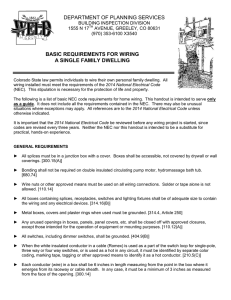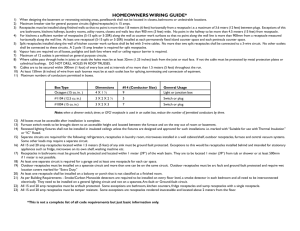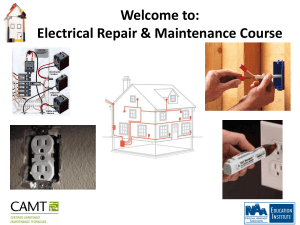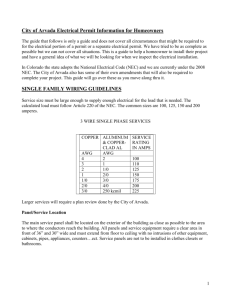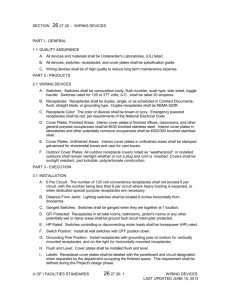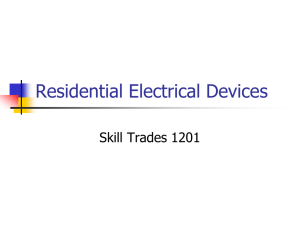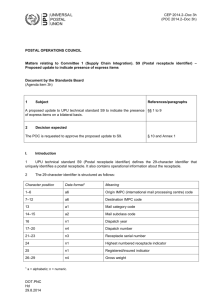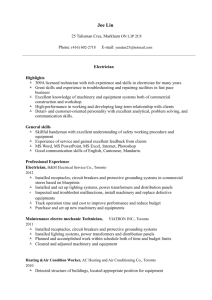department of planning services basic requirements
advertisement
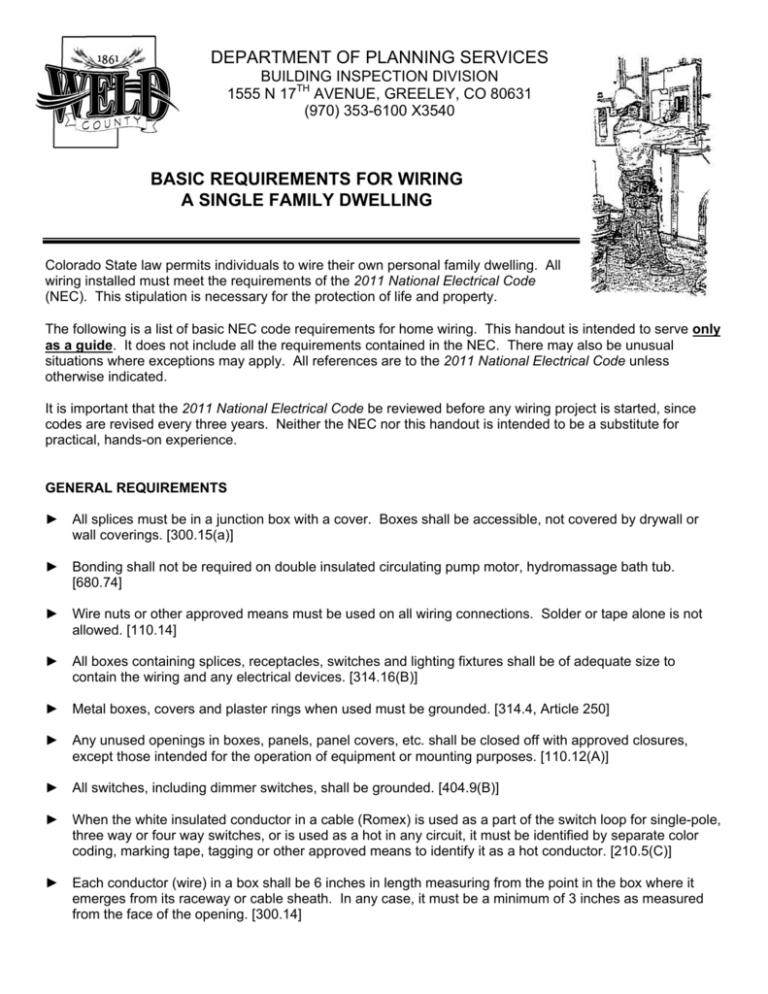
DEPARTMENT OF PLANNING SERVICES BUILDING INSPECTION DIVISION 1555 N 17TH AVENUE, GREELEY, CO 80631 (970) 353-6100 X3540 BASIC REQUIREMENTS FOR WIRING A SINGLE FAMILY DWELLING Colorado State law permits individuals to wire their own personal family dwelling. All wiring installed must meet the requirements of the 2011 National Electrical Code (NEC). This stipulation is necessary for the protection of life and property. The following is a list of basic NEC code requirements for home wiring. This handout is intended to serve only as a guide. It does not include all the requirements contained in the NEC. There may also be unusual situations where exceptions may apply. All references are to the 2011 National Electrical Code unless otherwise indicated. It is important that the 2011 National Electrical Code be reviewed before any wiring project is started, since codes are revised every three years. Neither the NEC nor this handout is intended to be a substitute for practical, hands-on experience. GENERAL REQUIREMENTS ► All splices must be in a junction box with a cover. Boxes shall be accessible, not covered by drywall or wall coverings. [300.15(a)] ► Bonding shall not be required on double insulated circulating pump motor, hydromassage bath tub. [680.74] ► Wire nuts or other approved means must be used on all wiring connections. Solder or tape alone is not allowed. [110.14] ► All boxes containing splices, receptacles, switches and lighting fixtures shall be of adequate size to contain the wiring and any electrical devices. [314.16(B)] ► Metal boxes, covers and plaster rings when used must be grounded. [314.4, Article 250] ► Any unused openings in boxes, panels, panel covers, etc. shall be closed off with approved closures, except those intended for the operation of equipment or mounting purposes. [110.12(A)] ► All switches, including dimmer switches, shall be grounded. [404.9(B)] ► When the white insulated conductor in a cable (Romex) is used as a part of the switch loop for single-pole, three way or four way switches, or is used as a hot in any circuit, it must be identified by separate color coding, marking tape, tagging or other approved means to identify it as a hot conductor. [210.5(C)] ► Each conductor (wire) in a box shall be 6 inches in length measuring from the point in the box where it emerges from its raceway or cable sheath. In any case, it must be a minimum of 3 inches as measured from the face of the opening. [300.14] ► Where more than one equipment grounding conductor is in a box, all must be tied together and secured with either wire nuts, grounding bar or other approved methods. [250.148] ► All supply wiring to ranges, wall-mounted ovens, counter-mounted cooking units, and clothes dryers shall be supplied by a four wire circuit. The receptacle used for these appliances shall be three-pole, four-wire (four prong) receptacle, and the cord shall be a four-wire cord. The grounded conductor (neutral) is not allowed to be used for grounding purposes. The equipment grounding conductor (ground wire) shall be used to ground any metallic boxes and the frame of these appliances. Be sure that the bonding strap is not connected between the neutral terminal and the frame of the appliance inside the appliance junction box. [250.134, 250.138, 250.140] ► Romex must be secured in place or stapled at intervals not exceeding 4 ½ feet and within 12 inches of every panel, box or fitting. Flat cables shall not be stapled on edge. [334.30] ► Romex cables are required to be kept back 1 ¼ inches from edge of wood members, such as studs or floor joists. [300.4(d)] ► All bored holes in wood must be 1 ¼ inches from the nearest edge of wood members. If this is not possible, approved nail plates must be installed. [300.4(a)(1)] ► Generally speaking, direct burial wire must be 24 inches deep. Electrical conduit needs to be 18 inches deep as measured to the top of the conduit. Any wiring that passes under a driveway, sidewalk etc., must be at least 18” deep. [Table 300.5] Wiring under buildings must be in conduit, type MC or type MI direct burial cable. ► Wet locations: Insulated conductors and cables installed in enclosures or raceways in underground installations shall be listed for use in wet locations Article 310.10(C). [300.5(B)] ► The Weld County Code, Chapter 29 requires that all underground utilities occupying the same trench, except gas lines, shall be in a separate trench and shall have a minimum one foot separation from each other. Underground wiring must be 12 inches horizontally from cesspools, septic tanks, septic tank drainage fields, or seepage pits [29.2.70 D, 29.2.50F, Weld County Code] ► Any PVC conduit used must be electrical conduit with electrical fittings. PVC used above ground and subject to physical damage shall be schedule 80. [300.50(C)] ► Smoke detectors shall be installed in each sleeping room and at a point centrally located in the corridor or area giving access to each separate sleeping area. A detector shall be installed on each story and in the basement. In new construction, the smoke detectors shall be supplied from the house wiring and shall be arc fault protected and contain battery backup. Such detectors shall be interconnected so that if one detector senses smoke, all smoke detectors will sound an alarm. [R313, 2006 International Residential Code] ► Call for rough-in inspections before installing drywall or wall coverings. Underground electric will need to be inspected before trenches are covered. ► Call for final inspection when all electrical work is completed. ► All penetrations to the building envelope must be sealed, caulked, gasketed or otherwise sealed. ELECTRICAL SERVICES ► Single Family Dwelling - nothing smaller than a 100 ampere, 3-wire electrical service is permitted. [230.79(c)] Revised 01/2012 Page 2 ► The electrical service disconnecting means containing overcurrent protection (main breaker panel) may be located inside the home at a readily accessible location if the service disconnecting means is placed backto-back with the metering equipment and the total service conductor length does not exceed 3 ½ feet measured from the exterior wall of the home. The service disconnecting means shall also be located on the ground level. [29.2.70A, Weld County Code] ► An intersystem bonding termination is required to be provided at the main service panel or the meter socket enclosure for bonding communication, radio or TV, satellite dish, etc. [250.94] ► Electrical panelboards shall not be located in clothes closets or bathrooms. [240.24(D), 240.24(E)] ► Panelboards are not permitted to be installed over stairs (including service upgrades). [240.24(F)] ► The working space around electrical equipment, including electrical panels, shall be 30 inches wide and 3 feet in front of the equipment. This space is from the floor to a height of 6 ½ feet or the top of the electrical equipment. This area shall be kept clear of any obstructions. [Table 110.26(A)(1), 110.26(A)(2), 110.26(E)] ► All remote buildings are required to have an equipment grounding conductor included in the feeder to the panel, and two ground rods shall be installed six feet apart. [215.6, 250.32(B)] ► For grounding purposes, the electrical service shall be grounded by a grounding electrode conductor (wire) from the electrical service to the concrete encased electrode [Article 250.32(3)]. If a concrete encased electrode (ufer ground) is installed, a copper water line is not required. Also, a grounding electrode conductor shall be run to a listed ground rod. The grounding electrode conductor must be unspliced. Grounding conductors smaller then No. 6 shall be in rigid metal conduit, intermediate metal conduit, rigid nonmetallic conduit (PVC, SCH. 80), electrical metallic tubing, or cable armor. [250.50, 250.64(B), Table 250.66] ► Where multiple concrete encased electrodes are available, only one needs to be used. [250.52(A)(30] ► All metal parts at the service equipment must be bonded together. This includes equipment such as meter housing, panelboards, gutters, splice boxes, and metal raceways and nipple. [250.92(A), Table 250.66] ► All conductors must be marked or identified. Phase (hot) conductors can be marked any color except white, gray, or green. The grounded conductor (neutral) is marked white. The bonding and grounding conductors are either green or all insulation is removed. [200.6, 250.119] ► Handles on main breakers in panels shall be installed so that the center of the circuit breaker, when at its highest position, is no more than 6 feet 7 inches above the floor or finished grade. [404.8] CIRCUITRY ► *Two or more 20-ampere circuits shall be installed for receptacles located above kitchen countertops. Nothing else may be supplied from these circuits except a refrigerator, an outlet for an electrical clock, or receptacles designed to provide power for gas-fired ranges, ovens, or counter-mounted cooking units. [210.11(C)(1)] [210.52(B)] ► *The location of countertop receptacles shall be as follows: A receptacle outlet shall be installed at each wall counter space that is 12 inches or wider. Receptacle outlets shall be installed so that no point along the wall line is more than 24 inches measured horizontally from a receptacle outlet in that space. In most cases, kitchen islands and peninsulas require at least one receptacle outlet. Such receptacles on islands and peninsulas shall not be located more than 12 inches below the countertop. See last page for drawing. [210.52(C)] ► In most cases, garbage disposals, dishwashers, and trash compactors require separate circuits. [210.23, 210.23(A)] Revised 01/2012 Page 3 ► Multi-wire branch circuits shall be provided with a means that will simultaneously disconnect all undergrounded conductors at the same point of origination. [210.4(A) & (B)] ► The laundry circuit must be on a separate 20-ampere circuit and no other outlets except those in the laundry room. [210.11(C)(2)] ► Dwelling unit branch circuits shall supply only loads within that dwelling unit or loads associated only with that dwelling unit. [210.25(A)] ► Central heating equipment, such as furnaces or boilers, shall be supplied by a separate circuit. The size of this circuit shall be determined by the load of the equipment and manufacturer’s specifications. [422.12] Such equipment shall be protected by a disconnecting means located in the same room and adjacent to the equipment. Fuses shall be sized according to Part D of Article 430. ► *In bathrooms, at least one receptacle shall be installed within 36 inches of each basin (sink). The receptacle outlet shall be located on a wall that is adjacent to the basin location. A single 20-ampere circuit shall be provided to supply the bathroom receptacle outlets. Such circuits shall have no other outlets. Exception: Where a 20-ampere circuit supplies a single bathroom, outlets for other equipment within the same bathroom shall be permitted to be supplied in accordance with Section 210.23(a). [210.11(c)(3), 210.11(c)(3) Exception, 210.52(d)] GENERAL PROVISIONS FOR RECEPTACLES ► In general living areas such as living rooms, bedrooms, dining rooms, family rooms, etc., a receptacle shall be located within 6 feet of door openings. Other receptacles shall be spaced at intervals not greater than 12 feet. [210.52(A)(1) and (2)] ► *There must be at least one receptacle outlet in bathrooms, attached garages, basements, and hallways over ten feet in length. [210.52(D), 210.52(G), 210.52(H)] ► In damp or wet locations all outdoor receptacles 120 volt or 250 volt are required to be listed weather resistant type. [406.9(A) and (B)] ► *At least one outdoor receptacle outlet is required at the front and back of the house. Such receptacles cannot be more than 6 ½ feet above the ground. [210.52(E)(1)] ► Balconies, decks and porches that are accessible from inside the dwelling unit shall have at least one receptacle outlet installed. [210.52(E)(3)] ► *A receptacle outlet is required in attics and crawlspaces where heating, air-conditioning, and refrigeration equipment is located. The receptacles must be located within 25 feet of the equipment and on the same level. [210.63] ► Tamper resistant receptacles are required in dwelling units in all areas specified in Article 210.52, all 125 volt, 15 and 20 amp receptacles shall be listed tamper resistant. [406.12] *GFCI protection may also be required in these areas GFCI REQUIREMENTS FOR RECEPTACLES Ground-fault circuit-interrupter (GFCI) protection for receptacles is required in the following locations: [210.8] ► All receptacles located in bathrooms. [210.8(a)(1)] ► All receptacles in dwelling garages and accessory buildings must be GFCI protected. [210.8(A)(2)] Revised 01/2012 Page 4 ► All outdoor receptacles [210.8(A)(3)] ► Receptacles in crawlspaces where the crawlspace is located at or below grade level. [210.8(A)(4)] ► Receptacles in unfinished basements or any portion thereof. [210.8(A)(5)] ► All receptacles installed to serve counter top surfaces, whether located on walls above counters or on islands and peninsulas. [210.8(A)(6)] ► Receptacle outlets installed to serve counter top surfaces and located within 6 feet of the outside edge of a wet bar sink. [210.8(A)(7)] ► Boathouses [210.8(A)(8)] GENERAL PROVISIONS FOR LIGHTING OUTLETS ► At least one light controlled by a light switch shall be installed in every habitable room such as bathrooms, hallways, stairways, outdoor entrances and exits, attached garages and detached garages with electrical power. [210.70(A)(1) and (2)] ► For attics and underfloor spaces containing equipment requiring servicing such as heating, airconditioning and refrigeration equipment, at least one lighting outlet containing a switch or controlled by a wall switch shall be installed. The switch shall be located at the point of entry to these spaces. The lighting outlet shall be provided at or near the equipment requiring servicing. [210.70(A)(3)] ARC-FAULT CIRCUIT PROTECTION ► All 120 volt, single phase, 15 and 20 amp branch circuits supplying outlets installed in dwelling unit family rooms, dining rooms, living rooms, parlors, libraries, dens, bedrooms, sunrooms, recreation rooms, closets, hallways or similar rooms or areas shall be protected by a listed arc fault circuit interrupter combination type. [210.12(A)] ► In any areas specified in 210.12(A), where branch circuit wiring is modified, replaced, or extended, the branch circuit shall be protected by an AFCI breaker or AFCI receptacle. [210.12(B)] RECESSED LIGHTING ► Recessed lighting must be installed to Section 410.110 and 410.116 of the NEC and Section 402.4.3 of the International Energy Conservation Code to limit air leakage between conditioned and unconditioned spaces by being: Type IC rated with no penetrations between the inside of the fixtures and ceiling cavity. Type IC or non-IC rated and installed in a sealed box constructed from ½” gypsum wallboard other approved assembly. Type IC rated, tested and labeled as to being “airtight”. Revised 01/2012 Page 5 4’ max 24” max In kitchens and dining areas of dwelling units, a receptacle shall be installed at each counter space wider than 12 inches. Receptacles shall be installed so that they are no more than four feet apart, measuring along the length of the counter top. Counter top spaces separated by range tops, refrigerators or sinks shall be considered as separate counter top spaces. Island and peninsula counter spaces longer than 24 inches and wider than 12 inches require at least one receptacle. All kitchen receptacles installed to serve counter top surfaces must be GFCI protected. (See handout for further information on kitchen and dining room receptacles.) Revised 01/2012 Page 6
